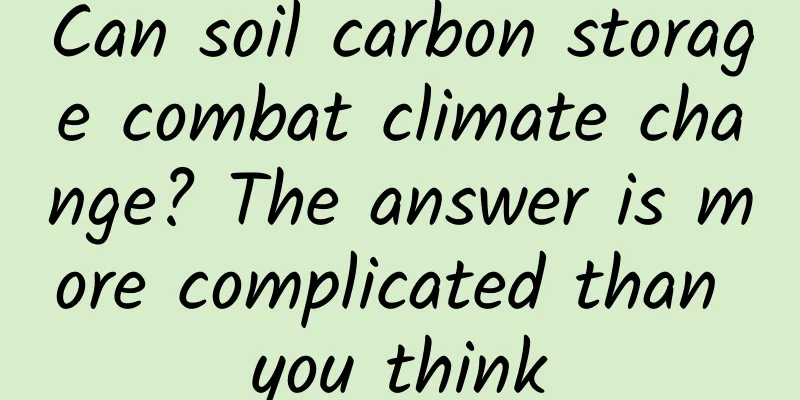Can soil carbon storage combat climate change? The answer is more complicated than you think

|
Plants convert carbon dioxide into roots, stems, and leaves through photosynthesis. The fallen branches and leaves and root products are buried in the soil and converted into soil organic matter. This is the traditional soil carbon sink. In simple terms, soil can absorb, convert, and store carbon dioxide from the atmosphere through plants. However, recent studies have shown that the truth may not be that simple. This has to start with the complex composition of soil. A teaspoon of healthy soil contains more bacteria, fungi and other microorganisms than humans on Earth. Soil humus has always been considered to be a type of complex and stable macromolecular organic matter formed during the humification process of organic materials, with the emphasis on the word "stable". However, recent studies[1] have shown that “current evidence does not support the formation of large, persistent ‘humus’ in soils.” Over the past decade or so, most soil scientists have come to accept this view. Yes, soils vary widely and contain a lot of carbon. But this carbon is not stored away forever, unbroken. "The properties and characteristics of soil, the stuff that's in the textbooks, the theory of soil organic carbon accumulation has been proven to be mostly wrong ... but we still stick to it," said Greg Sanford, a soil researcher at the University of Wisconsin-Madison. This will not only lead to more considerations for soil-based nature-based solutions, but will also cause serious deviations in previous climate models. Studies have shown that soil carbon storage capacity is highly sensitive to temperature changes, which has a significant impact on important carbon pools such as tropical rainforests [2]. In addition, the carbon sequestration and emission reduction potential of agriculture also needs to be considered. Soil organic carbon pool accounts for about 2/3 of the entire terrestrial ecosystem, about 3 times the plant carbon pool and 2 times the atmospheric carbon pool. According to the data in the Second National Assessment Report on Climate Change, the reserves of China's soil carbon pool are about 102.96 billion tons. If the carbon credit calculation based on this data is wrong, the time we have to mitigate climate change may be much shorter than we think. In terms of agriculture, the 2015 United Nations Paris Climate Change Conference proposed the "4/1000" initiative, which aims to increase the organic carbon storage of global agricultural soils by an average of 4/1000 per year. The European Union and other countries have also issued sustainable agriculture bills, hoping to accelerate the natural carbon sequestration process from the soil. In addition to soil degradation, compaction, acidification, salinization, nutrient imbalance, erosion and other problems, we also need to consider in detail the impact of agriculture on soil carbon storage capacity. In recent years, soil science researchers have been studying how to really and continuously fix carbon in the soil. Salk's team proposed the idea of using plants rich in suberin to fix carbon in the soil. In April 2021, the United States proposed paying farmers to grow cover crops to nourish the soil. (There is evidence that when the roots of cover crops decompose, some of their carbon remains in the soil.) However, whether these practices are really effective will take time to consider. (Content reference: https://advances.sciencemag.org/content/7/21/eabd1343) Text/Stan Review/YJ [1] Lehmann, J., Kleber, M. The contentious nature of soil organic matter. Nature 528, 60–68 (2015). https://doi.org/10.1038/nature16069 [2] Nottingham, AT, Meir, P., Velasquez, E. et al. Soil carbon loss by experimental warming in a tropical forest. Nature 584, 234–237 (2020). https://doi.org/10.1038/s41586-020-2566-4 |
>>: Why are the seats in the subway designed to be slippery?
Recommend
The consequences of not brushing your teeth carefully: In addition to tooth decay, strawberry seeds may also sprout between your teeth?
Winter strawberries are almost on the market agai...
The efficacy and function of pink green vine
There are many common Chinese medicinal materials...
How to eat Dendrobium
Dendrobium, everyone knows how to use it? Do you ...
There have been many electric vehicle fires recently. Do you still charge them this way?
recently Several fires caused by electric vehicle...
Six people were infected in one meal! Can boiling the dishes and chopsticks before eating really disinfect them?
Confirmed cases in Shanghai involved 4 restaurant...
The efficacy and function of white azalea
White azalea is a very good medicinal material. I...
Do we rely on Haloxylon ammodendron to find water, fix sand and strengthen virility?
Because of the Ant Forest, Haloxylon ammodendron ...
Angel or devil? Don’t be fooled by its cute appearance, it is actually very ferocious!
In the cold and dark deep sea, a cute little crea...
How long will it take for humans to reach the moon? Why must it be done at a very fast speed? Can we just fly there slowly?
This article is based on answering a question fro...
What are the functions of Radix Pseudostellariae?
Nowadays, traditional Chinese medicine is becomin...
Computing power in the digital age: Unlocking the power of artificial intelligence
In the context of artificial intelligence (AI), &...
The efficacy and function of cypress branches
Most Chinese medicinal materials have good effect...
This boy band disbanded, not because of their mediocre singing, but because...
There are few insects whose names are often unkno...
World Book Day丨You look so beautiful when you read!
Reading enriches our souls. Let us have more cour...









